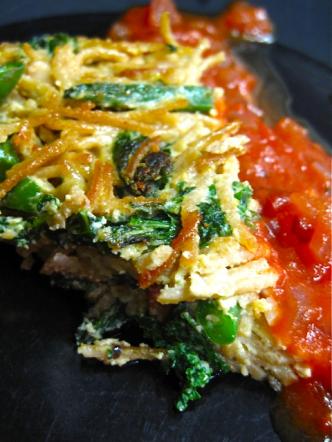This is part 4 of a summer long series about our CSA boxes and what we do with them. Recipes for a white wine vinaigrette and crab and lentil salad follow.
This was the week where failing in the kitchen was the prevailing theme. Normally, nine out of ten times, I hit home runs. Of course, some meals are more compelling than others, but usually the worst are still edible. This week, I was in a slump. I wanted nothing to do with my last couple of dishes.
Leaden vegetable fritters and gag-inducing spaghetti carbonara that I tried to lovingly scent with lemon zest and Serrano chili were on the menu. The foul food ate up most of my week’s CSA vegetables. Beans, snap peas, spring onions, golden cauliflower, and kale: they all perished and the remaining scraps went straight into the vegetable stock bag in my freezer.
 The spaghetti pie of necessityThe fritters could not be salvaged, but I smashed the spaghetti carbonara into a pan and fried both sides until crispy. My spaghetti pie was actually quite nice, especially when covered with a simple, homemade tomato sauce. I wouldn’t recommend you recreate my carbonara fail just for a spaghetti pie, but it doesn't mean that you should be afraid to try a CSA inspired carbonara. The fritter recipe I attempted can be found at Bluebird Gardens and Smitten Kitchen. If you don’t have broccoli, try substituting your choice of vegetables, but learn from my mistakes; use as little flour as possible and fry the fritters in a hot skillet instead of using an electric griddle.
The spaghetti pie of necessityThe fritters could not be salvaged, but I smashed the spaghetti carbonara into a pan and fried both sides until crispy. My spaghetti pie was actually quite nice, especially when covered with a simple, homemade tomato sauce. I wouldn’t recommend you recreate my carbonara fail just for a spaghetti pie, but it doesn't mean that you should be afraid to try a CSA inspired carbonara. The fritter recipe I attempted can be found at Bluebird Gardens and Smitten Kitchen. If you don’t have broccoli, try substituting your choice of vegetables, but learn from my mistakes; use as little flour as possible and fry the fritters in a hot skillet instead of using an electric griddle.
Before I share my actual successful cooking attempts, let me explain that I have a weakness for creamy salad dressings. I’m not quite the “Ranch dressing on everything” gal (except for when it comes to my employer’s cafeteria food) but vinaigrettes never really thrilled me. However, when I worked at Spoonriver, I became enthralled with their beautiful vinaigrettes. My version reminds me of their white balsamic vinaigrette found in The Spoonriver Cookbook. I’m not sure why it took me so long to try making my own version, but now that I have, there’s no looking back.
Fortunately, I quickly discovered that unlike my other cooking experiments, homemade vinaigrettes are nearly foolproof and exponentially tastier than anything ever found in a bottle. Any fresh or dried herbs can be added to your vinaigrette and excess can be stored in the fridge for additional uses.
Recently, my Godmother treated me to salads she brought home from Café Latte. My favorite was made with quinoa, vegetables, lettuce greens, and imitation crab tossed in a tart vinaigrette. Imitation crab may seem like hotdogs from the sea, so only use it if you dare. Tuna, salmon, or poached shrimp would make fine substitutions. I chose to go down the dark and mysterious path of fake crab. Then, I tossed it with the vinaigrette, lentils and CSA vegetables.
When that cold salad was gone, I tossed the same vinaigrette with the leftover lentils, caramelized onions, and fresh sautéed tomatoes and zucchini for a spontaneous "warm" salad. Create your own medley of vegetables and grains based upon what’s available in your cupboards and CSA box. Or try using extra vinaigrette to dress a warm or cold potato salad.
My recipe failures were a good reminder that simple combinations often trump the overwrought. Here’s to a new week: a week where I go back to the basics and keep it even simpler with ears of sweet corn, purple potatoes, and Walla Walla onions...and perhaps some more vinaigrette.
And if all else fails and it’s time to call it quits, there’s always cucumber and cream cheese sandwiches.

Slightly Sweet White Wine Vinaigrette
I like my vinaigrette tart and sweet and use about a 1/1 ratio of vinegar to oil, leaning heavier on the oil. This week, I used white wine vinegar but you could try other types such as balsamics, apple cider vinegar, red wine vinegar or sour citrus juices. I typically make 1 cup of dressing at a time, adding a couple good squirts each of honey and Dijon mustard. If you don’t have Dijon mustard, substitute dried or course grain. And if you don’t have honey, use a different sweetener such as agave nectar, maple syrup or brown sugar.
First, mix the vinegar, one clove of minced garlic, herbs, white pepper, Dijon mustard, and honey. Then, slowly stream in of olive oil, whisking quickly to emulsify. Lastly, taste for seasoning, adding a pinch of salt to taste and balance the flavors to your liking. Too tart? Wisk in more oil and/or add more sweetener.
Cold Crab and Lentil salad-Inspired by Cafe Latte
Six sticks of imitation crab, roughly chopped
2 cups of lentils cooked and cooled
Green beans, blanched and cut into bite-sized pieces
Raw snap pea pods, sliced into bite-sized pieces
Minced red onion, to taste
Fresh herbs
Salt and pepper to taste
Vinaigrette
Salad greens
Lemon or lime wedges to garnish
Directions
To cook the lentils, first rinse well and examine for any little stones.
Saute with a little oil or butter until toasty. Cover with twice as much water. Bring to a boil, simmer, cover, and cook until tender. If the water evaporates before the lentils are tender, add more water. Drain off any excess. For even tastier lentils, substitute veggie or meat broth for some of the water.
To blanch green beans, bring a pot of salted water to a boil. Place trimmed green beans in the boiling water for a couple of minutes and shock in ice water until cooled. Drain.
Combine lentils, vegetables, herbs, salt, pepper and vinaigrette. Toss with salad greens and serve with additional lemon wedges.
Warm vegetable salad
Toss the vinaigrette with any leftover lentils and your choice of sautéed vegetables. Serve warm. It’s even better the next day.

Jeni Hill grew up in the Twin Cities and recently moved to Fargo. Her two sustaining passions are food and writing and she combines the two whenever she gets the chance. Jeni believes food is never just about the food and considers it the finest medium to connect with others. When she is not crafting contributions to Simple Good & Tasty, she may be posting to her blog An Herbalist Eats, 20food, or Fargo's High Plains Reader. Her last non-CSA article for us was: An adopted Korean makes her first batch of lefse.




